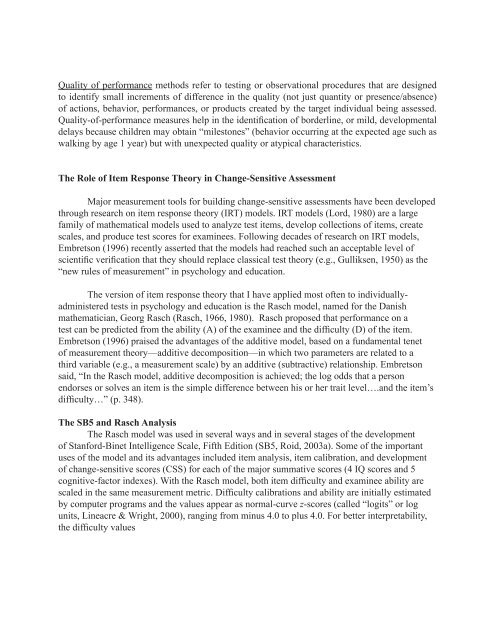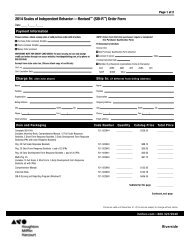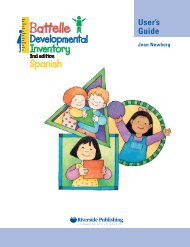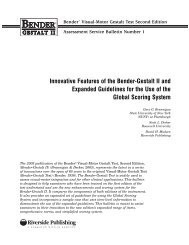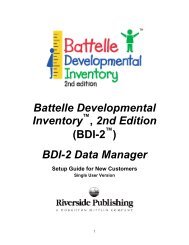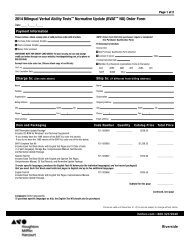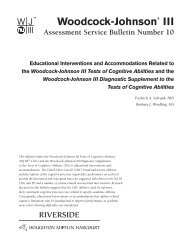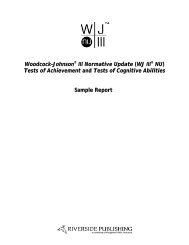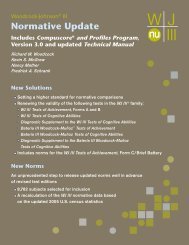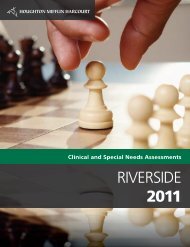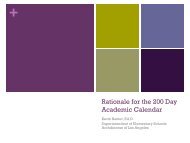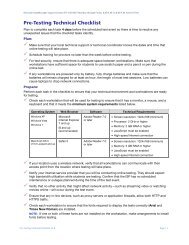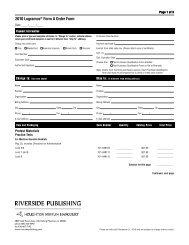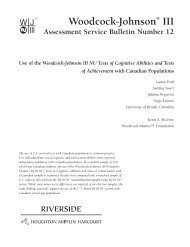Quality of Performance and Change-Sensitive ... - Nelson Education
Quality of Performance and Change-Sensitive ... - Nelson Education
Quality of Performance and Change-Sensitive ... - Nelson Education
You also want an ePaper? Increase the reach of your titles
YUMPU automatically turns print PDFs into web optimized ePapers that Google loves.
<strong>Quality</strong> <strong>of</strong> performance methods refer to testing or observational procedures that are designedto identify small increments <strong>of</strong> difference in the quality (not just quantity or presence/absence)<strong>of</strong> actions, behavior, performances, or products created by the target individual being assessed.<strong>Quality</strong>-<strong>of</strong>-performance measures help in the identification <strong>of</strong> borderline, or mild, developmentaldelays because children may obtain “milestones” (behavior occurring at the expected age such aswalking by age 1 year) but with unexpected quality or atypical characteristics.The Role <strong>of</strong> Item Response Theory in <strong>Change</strong>-<strong>Sensitive</strong> AssessmentMajor measurement tools for building change-sensitive assessments have been developedthrough research on item response theory (IRT) models. IRT models (Lord, 1980) are a largefamily <strong>of</strong> mathematical models used to analyze test items, develop collections <strong>of</strong> items, createscales, <strong>and</strong> produce test scores for examinees. Following decades <strong>of</strong> research on IRT models,Embretson (1996) recently asserted that the models had reached such an acceptable level <strong>of</strong>scientific verification that they should replace classical test theory (e.g., Gulliksen, 1950) as the“new rules <strong>of</strong> measurement” in psychology <strong>and</strong> education.The version <strong>of</strong> item response theory that I have applied most <strong>of</strong>ten to individuallyadministeredtests in psychology <strong>and</strong> education is the Rasch model, named for the Danishmathematician, Georg Rasch (Rasch, 1966, 1980). Rasch proposed that performance on atest can be predicted from the ability (A) <strong>of</strong> the examinee <strong>and</strong> the difficulty (D) <strong>of</strong> the item.Embretson (1996) praised the advantages <strong>of</strong> the additive model, based on a fundamental tenet<strong>of</strong> measurement theory—additive decomposition—in which two parameters are related to athird variable (e.g., a measurement scale) by an additive (subtractive) relationship. Embretsonsaid, “In the Rasch model, additive decomposition is achieved; the log odds that a personendorses or solves an item is the simple difference between his or her trait level….<strong>and</strong> the item’sdifficulty…” (p. 348).The SB5 <strong>and</strong> Rasch AnalysisThe Rasch model was used in several ways <strong>and</strong> in several stages <strong>of</strong> the development<strong>of</strong> Stanford-Binet Intelligence Scale, Fifth Edition (SB5, Roid, 2003a). Some <strong>of</strong> the importantuses <strong>of</strong> the model <strong>and</strong> its advantages included item analysis, item calibration, <strong>and</strong> development<strong>of</strong> change-sensitive scores (CSS) for each <strong>of</strong> the major summative scores (4 IQ scores <strong>and</strong> 5cognitive-factor indexes). With the Rasch model, both item difficulty <strong>and</strong> examinee ability arescaled in the same measurement metric. Difficulty calibrations <strong>and</strong> ability are initially estimatedby computer programs <strong>and</strong> the values appear as normal-curve z-scores (called “logits” or logunits, Lineacre & Wright, 2000), ranging from minus 4.0 to plus 4.0. For better interpretability,the difficulty values


